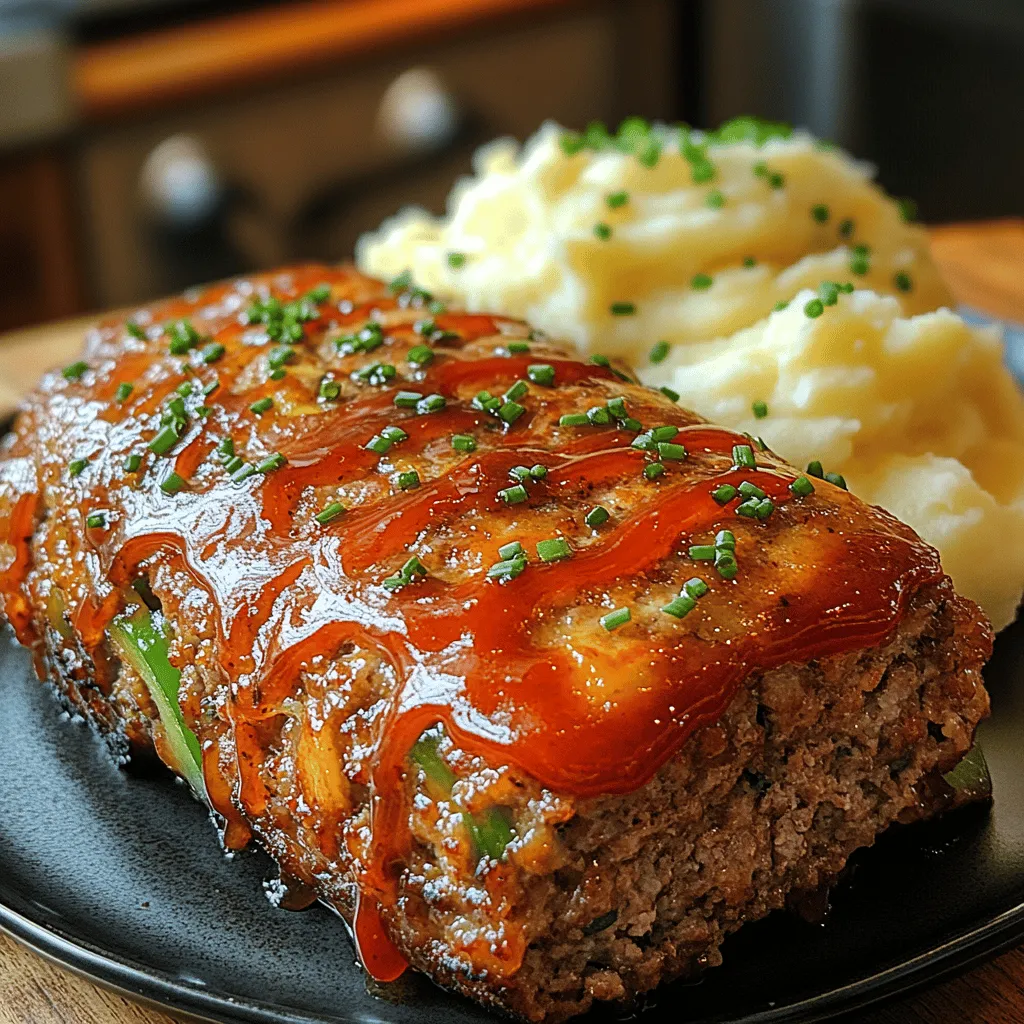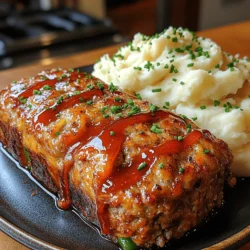Introduction
The Ultimate Comfort Meal: Homestyle Meatloaf with Mashed Potatoes is more than just a dish; it’s a heartfelt creation that evokes memories of family gatherings, Sunday dinners, and the warm embrace of home-cooked goodness. This classic meal has a unique ability to bring people together, making it a staple in kitchens across America. Whether you’re looking to serve a cozy family dinner or impress guests with your culinary prowess, this hearty dish is guaranteed to satisfy both hunger and nostalgia.
In this article, we will explore the rich history of meatloaf, highlight the significance of mashed potatoes as the perfect accompaniment, and provide a comprehensive, step-by-step guide to crafting this delicious meal from scratch.
The Comforting Appeal of Meatloaf
Exploring the History and Tradition of Meatloaf
Meatloaf has deep roots in American cuisine, tracing its origins back to the early 19th century. It is believed that the dish was inspired by various European meat dishes, particularly the German “Fleischlaibchen” and the British “meat pudding.” As immigrants brought their culinary traditions to the United States, meatloaf evolved into a beloved American classic.
Over the years, variations of meatloaf have emerged across cultures, showcasing regional ingredients and unique flavor profiles. From the Italian meatloaf known as “polpettone” to the Greek “kreatopita,” which incorporates spices and herbs native to the Mediterranean, the versatility of meatloaf is a testament to its adaptability and appeal.
In American households, meatloaf has become synonymous with family meals and gatherings. It’s a dish that is often passed down through generations, with each family adding their own twist to the traditional recipe. The simplicity of preparation and the ability to feed a crowd make meatloaf a go-to option for any occasion.
Understanding Why Meatloaf is a Comfort Food
The emotional connections and memories associated with meatloaf are what truly elevate it to the status of comfort food. Many people remember the aroma of a baking meatloaf wafting through the house, signaling that dinner was almost ready. This nostalgic experience is often intertwined with family gatherings, where laughter and stories are shared around the dinner table.
Beyond its emotional resonance, homemade meatloaf also offers nutritional benefits. Packed with protein from the meat and often enriched with vegetables and whole grains, it can be a wholesome meal option. Moreover, the ability to customize the ingredients allows for a healthier take on this classic dish, accommodating various dietary preferences and restrictions.
Meatloaf’s versatility is another reason for its enduring popularity. With the option to experiment with flavors and ingredients—from incorporating different types of meat to adding vegetables, cheeses, or seasonings—each meatloaf can be a unique creation. This adaptability ensures that it remains a relevant and cherished recipe in modern kitchens.
The Perfect Pairing: Mashed Potatoes
The Role of Mashed Potatoes in Comfort Meals
No comfort meal is complete without the perfect side, and mashed potatoes are the quintessential accompaniment to meatloaf. Their creamy texture and rich flavor provide a delightful contrast to the savory, hearty meatloaf, creating a balance that is both satisfying and indulgent.
Historically, mashed potatoes have held a significant place in American dining. They became a staple after the introduction of the potato to the New World in the 18th century, quickly gaining popularity for their versatility and ease of preparation. As the country evolved, so too did the ways in which mashed potatoes were prepared, from the traditional buttery and creamy style to more modern interpretations featuring garlic, cheese, or herbs.
The various styles of mashed potatoes—from creamy and smooth to chunky and rustic—allow for endless creativity in the kitchen. You can customize your mashed potatoes to suit your taste preferences, whether you prefer a classic buttery version or a more adventurous garlic-roasted variety. This adaptability makes mashed potatoes the perfect partner for meatloaf, enhancing the overall dining experience.
Ingredient Breakdown for the Ultimate Meatloaf
Key Components of the Meatloaf
Creating the ultimate homestyle meatloaf starts with selecting the right ingredients. The foundation of a great meatloaf is the meat itself, and using a blend of ground beef and ground pork can elevate the dish. Ground beef provides a robust flavor and hearty texture, while ground pork adds moisture and a subtle sweetness that balances the dish perfectly.
Another essential ingredient in meatloaf is breadcrumbs. They play a crucial role in achieving the desired texture, helping to bind the meat together while also adding a satisfying bite. Whether you choose traditional breadcrumbs, panko, or even crushed crackers, the choice can significantly affect the final result.
Aromatics such as onion, bell pepper, and garlic are integral to enhancing the flavor of your meatloaf. Sautéing these ingredients before mixing them into the meat adds depth and richness to the dish, creating a savory base that complements the meat perfectly.
Seasoning and Flavor Enhancements
No meatloaf would be complete without the right seasoning. Worcestershire sauce and ketchup are classic staples that not only add flavor but also contribute to the moisture of the meatloaf. Worcestershire sauce brings a savory umami note, while ketchup adds a touch of sweetness and tang.
When it comes to herbs, thyme and oregano are excellent choices that elevate the flavor profile of your meatloaf. These herbs bring a freshness that balances the richness of the meat, making every bite a delicious experience.
As we move forward, we’ll dive deeper into the preparation steps for this ultimate comfort meal, ensuring you have all the knowledge needed to create a delicious homestyle meatloaf with fluffy mashed potatoes that will warm hearts and fill stomachs.

Balancing Flavors with Salt and Pepper
Achieving the perfect flavor balance in your homestyle meatloaf starts with the foundational seasonings: salt and pepper. These two ingredients enhance the natural taste of the meat and other components of the mixture. Start by seasoning the meat mixture lightly, then adjust to your taste preference. Remember, it’s easier to add more seasoning later than to fix an over-salted dish. A good rule of thumb is to taste a small bit of the raw mixture (with no eggs for safety) to gauge the seasoning before baking.
Step-by-Step Instructions for Meatloaf
Preparing the Meatloaf Mixture
For a successful meatloaf, the mixture is where the magic happens. Begin by gathering your chosen ground meat, typically a combination of beef and pork for depth of flavor.
How to Achieve the Perfect Texture
The key to a tender meatloaf is moisture and fat content. If you’re using lean meats, consider adding ingredients like breadcrumbs soaked in milk or finely chopped vegetables (like onions and bell peppers) which will contribute to moisture. Aim for a ratio of about 80% meat to 20% filler (like breadcrumbs) to maintain a juicy texture without being dense.
Tips on Mixing Without Overworking the Meat
To prevent a tough meatloaf, mix the ingredients just until combined. Overworking the mixture can lead to a rubbery texture. Use your hands or a spatula, and be gentle. Incorporate the seasonings, eggs, and any other ingredients without excessive kneading.
Shaping and Baking the Meatloaf
Once your mixture is well-combined, it’s time to shape your meatloaf.
Options for Shaping: Loaf Pan Versus Baking Sheet
You can choose to shape your meatloaf in a loaf pan for a classic presentation or form it into a free-standing loaf on a baking sheet for a more rustic appearance. Using a loaf pan helps maintain the shape and can create a nice crust around the edges. On the other hand, a baking sheet allows for even cooking and a crispier exterior. Whichever method you choose, ensure to line your pan or sheet with parchment paper for easy cleanup.
Understanding the Importance of Resting Time Post-Baking
After baking, allow your meatloaf to rest for at least 10 minutes before slicing. This resting period helps the juices redistribute throughout the meatloaf, making each slice more flavorful and preventing it from falling apart.
Crafting the Creamy Mashed Potatoes
A classic meatloaf is incomplete without a side of creamy mashed potatoes. Here’s how to make the perfect accompaniment.
Preparing the Potatoes for Mashing
Selecting the Right Type of Potato
For the creamiest mashed potatoes, Yukon Gold or Russet potatoes are ideal. Yukon Golds provide a buttery flavor and smooth texture, while Russets are starchy and fluffy. Choose potatoes that are similar in size for even cooking.
The Boiling Process: Achieving Fork-Tender Potatoes
Start by peeling the potatoes and cutting them into uniform chunks, about 1-inch pieces. Place them in a pot of cold, salted water and bring it to a boil. Cooking them in cold water helps ensure they cook evenly. Boil until the potatoes are fork-tender, which usually takes about 15-20 minutes. Drain them thoroughly to remove excess moisture before mashing.
Mashing Techniques for Creamy Results
Incorporating Buttermilk and Butter for Richness
For ultra-creamy mashed potatoes, use a combination of buttermilk and butter. Start with about 1/4 cup of buttermilk and 4 tablespoons of unsalted butter. This combination creates a rich, velvety texture. For the best results, use a potato masher or a ricer; this avoids gluten formation, ensuring your mashed potatoes remain light and fluffy.
Seasoning Tips for the Best Flavor
Once the potatoes are mashed, season them generously with salt and white pepper to taste. White pepper maintains the beautiful color of the potatoes. You can also add minced garlic or cream cheese for added flavor if desired. Taste and adjust as necessary to ensure the seasoning enhances the potatoes without overpowering their natural flavor.
Serving Suggestions
Creating an appealing plate is as important as cooking techniques in delivering a satisfying meal.
How to Slice the Meatloaf for Optimal Presentation
When ready to serve, slice the meatloaf with a sharp knife, using a sawing motion to prevent it from crumbling. Aim for slices about 1-inch thick for a hearty portion. Lay the slices on a plate, slightly overlapping them for visual appeal.
Ideas for Garnishing with Herbs Like Chives or Parsley
For an added touch of color and freshness, consider garnishing your meatloaf with freshly chopped herbs. Chives or parsley not only enhance the presentation but also add a burst of flavor. Sprinkle a few leaves on top of the meatloaf or around the plate for an inviting look.
Enhancing the Meal with Sauces
A delicious sauce can elevate your meatloaf to new heights.
Exploring Ketchup Versus Savory Gravy Options
The classic choice for meatloaf is a ketchup glaze, which adds sweetness and tang. Simply mix ketchup with a touch of Worcestershire sauce and spread it over the top before baking. Alternatively, a savory brown gravy can complement the flavors perfectly. Prepare a simple gravy from the drippings or use a store-bought option for convenience.
Suggestions for Side Dishes to Round Out the Meal
While creamy mashed potatoes are a must, consider adding other sides to create a balanced meal. Steamed green beans or roasted Brussels sprouts work beautifully alongside meatloaf, providing color and nutrients. A simple garden salad can also add freshness and crunch to your plate.
Conclusion
The Ultimate Comfort Meal: Homestyle Meatloaf with Mashed Potatoes is not just a dish; it is an experience that brings people together. With its rich flavors and comforting textures, this meal is perfect for any occasion, whether it’s a casual family dinner or a special gathering. By mastering this recipe, you not only create a delicious meal but also carry forward a cherished tradition of home-cooked comfort food. Enjoy the process of cooking and savor the delightful results as you share this meal with loved ones. With the right techniques and a little care, your meatloaf and mashed potatoes will become a family favorite, treasured for generations to come.

